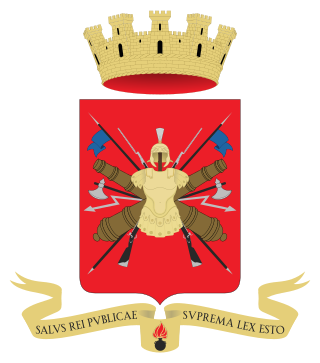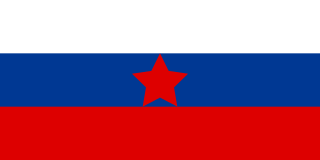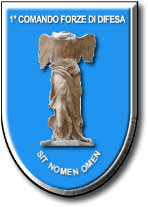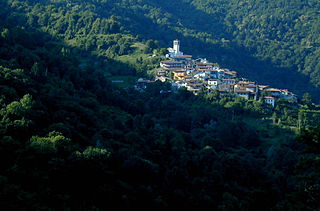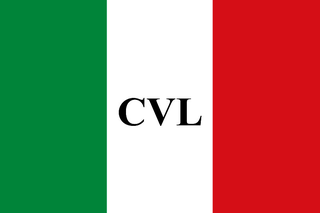1945 and contrasts between Osoppo and Garibaldi partisans
The Gruppo Brigata Osoppo dell'Est (Group of East Osoppo Brigade), a unified command with the Divisione Garibaldi Natisone, did not accept to pass east of the Isonzo river and to be subordinated to the Slovenian 9th Corps of the National Liberation Army of Yugoslavia led by Josip Broz Tito. On 22 November 1944, the Italian Communist Party (and not the CLNAI, the only command allowed to give orders legitimately regarding the operative deployment of partisan forces) ordered to the Italian partisans located in the zone to pass under the dependence of the Yugoslav 9th Corps in order to create (according to Palmiro Togliatti in a letter to Vincenzo Bianco, PCI representative in the 9th Corps):
A completely different condition from the one existing in the free part of Italy. In conclusion, a democratic situation will be created.
— Palmiro Togliatti [27]
The disposition provided that "all the Italian units of the zone [the Friulian Adriatic Littoral] must operate only under the command of the 9th Army Corps of Tito", adding that whoever refused this order would be considered as fascist and imperialist; the command of Osoppo Brigades repealed the requested saying pai nostris fogolârs in Friulan ("For our homes"). [28]

Over 3,500 communist partisans of Garibaldi-Natisone division accepted but not the autonomous of Ossopo, including Elda Turchetti, a militant killed and reputed by communists as an X MAS spy. [27]
If the Osoppo members were based on principles of defence of national interests, which should have been discussed only after the end of the war, Garibaldi partisans were also very doubtful given the political positions and authoritarian methods adopted by Slovenian in their territories.
[...] It is wrong to mobilize people who are not only not in favour but are against it; it is wrong to impose Slovenian in schools, if this is not required by those concerned; it is harmful to respond with hostile acts and threats to the opposition of the population [...]
— Giovanni Padoan [29]
Despite that, almost 1,500 Garibaldi partisans, even with hardship, were obliged to accept the strategy of PCI leaders on 24 December 1944 and they crossed the Isonzo. Their command moved toward Circhina and Zakriž, in the current Slovenia. At the end of the war, Garibaldi partisans were sent to free Lubiana and not Trieste, as initially promised.
It is a serious decision, a big mistake, because it is clear that Slovenians have changed their position on the border issue and we should not accept the request of the 9th Corps.
Allied missions and conflict between Osoppo and Garibaldi Brigades
Since July 1944, the American Office of Strategic Services (OSS) had begun a linking mission in Friuli with the partisan called Chicago-Texas. This mission was led by two Italian agents affiliated to PCI, Alfredo Michelagnoli and Giuseppe Gozzer. [31]
The mission was organized accordingly to a wider agreement between OSS and PCI, providing the enrolment of "experienced men" appointed by the party, in exchange for the use of the radio of the secret service by the party in order to communicate with their leaders in the territories occupied by nazi-fascists. [32]
However, Gozzer, although he headed a mission of the Allies, began soon the chief of staff of the Brigata Garibaldi-Friuli, generating uncertainties among the members of Special Operations Executive (SOE, one of the British secret services for the operation behind the enemy lines) already active in the zone, who did not know when consider the initiatives of Gozzer as adopted in his qualify as representative of Americans or in that of communist partisan commander. [31]
On the other hand, there was not any specific coordination between the missions of OSS and SOE and this situation generated "the most complete confusion", [33] putting in involuntary competition the missions started independently on the same territory, and provoking inefficiency and undue dangers for the Allies agents themselves. [34] Moreover, the different approach of the Allied missions did not provide to partisans a coherent figure of the Anglo-American alliance and made their military action less efficient. [35]
The scarcity of material sent by air by the Allies (always subordinated to the needs of war on other fronts and starting from a limited availability) and the notable gap between the promises of missions and the material actually sent (beside the different promises of OSS and SOE agents), induced the local Resistance to a cynical attitude following the development of a lack of trust in the Allies, thus encouraging revolutionary propaganda and adherence to pro-Soviet tendencies. [36]
In general, as Claudio Pavone explains, if the supplies did not reach the brigades, or few came, partisans often tended to believe that this was due to the fact that "the British and American armies were still instruments of two capitalist and imperialist powers and imperialist". [37] [38]
Agent Nicholson of the British service, who also supported the Garibaldi groups in negotiations with the Osoppo Brigades, assessed the work of Gozzer with extreme harshness, [39] [40] stigmatizing how, in his opinion, the OSS was relying on a "mercenary puppet" completely under the control of "the most violent communist" in northern Italy. At the same time, Michelagnoli sent reports to the OSS in which he praised the Garibaldi Brigades for their "fighting spirit" and "sure anti-fascism", while he accused the Osoppo of having numerous ex-fascists and politically compromised personalities among their members, while remarking that there were no noteworthy incidents between the two formations. [31]
A different version was given by reports of another OSS mission - led by the American Major Lloyd Smith - sent to the area and controlled by a section of the service different from the one responsible for the Chicago-Texas. Lloyd Smith, in his reports, indicated Gozzer as an active communist propagandist, consciously committed to sabotaging peace attempts between various partisan groups in which Lloyd Smith himself was engaged. Lloyd Smith unsuccessfully asked his command to be given the necessary authority to impose his point of view - that it was the political one on the Allied side, considering the pacification and coordination between Osoppo and Garibaldi as useful and necessary - arriving at threaten the withdrawal of their mission. In November 1944 similar protests of the British side, relating to the same situation, came to the OSS command of Caserta. However, the head of the criticized mission, Suhling, severely rejected the accusations, turning them over Nicholson and Smith, claiming that they were the ones who gave a political connotation to their action in order to "unify formations of different ideological origins", thus contributing to interpret allied action as a "political pressure" and claiming to "influence if not to lead" the partisan organizations. Suhling concluded by proposing the removal of Smith. [39]
The tiring but largely unsuccessful attempts of pacification and unification of the Osoppo and Garibaldi Brigades conducted by British agents during the summer of 1944 failed definitively when the area was subjected to violent raids by Germans. Nicholson could only acknowledge that, among the Garibaldi, the hostility towards the Allies (due to the lack of supply launches and to the poor progress of the advance in Italy) and to the Osoppo had grown, rather than decreased. At the same time the Garibaldi had increased their political activity. Indeed, the British agents had been threatened with arrests and executions. Following these facts and threats, Nicholson himself moved to Udine, thus abandoning his sector. On the eastern side of the Tagliamento river (which constituted a true natural border with a large gravel bed about one kilometre wide) the situation was even more difficult, as this territory was openly claimed by the Yugoslav partisans. These combined a strongly hostile policy towards the Osoppo with a continuous pressure so that the Garibaldini were placed directly at their dependencies. An allied agent sent to the area, led by Major Thomas MacPherson, wrote a report to his command in which he stated that the Slovenian 9th Corps considered the major and the Osoppo as collaborators of the Germans and that, for this reason, both the British mission and the Osoppo had to be eliminated at any cost, as they were considered elements that opposed their annexation design. The Osoppo Brigades, in particular, were considered as the "natural enemy" by Slovenian partisans, who led violent propaganda against them, disarming them wherever possible, and denying them any right to recruit. At that point, the agent concluded, the Osoppo Brigades were fighting against seven enemies at once: the Germans, the Russians (serving the Germans), the RSI Fascists, the Slovenians, the Garibaldi partisans, the civil spies and the winter.
In November 1944, the Garibaldi Natisone division passed under the direct dependence of Slovenians, closing each contact with the Osoppo. MacPherson, solicited also by the Allied command of Caserta tried to do a last but vain mediation. On 15 December 1944 MacPherson met the leaders of Natisone and complained how, since their passage to the 9th Corps, frequent incidents occurred between the Garibaldi and Osoppo Brigades, adding that the political divergences had to be absolutely postponed to the end of the war and that they could not be a hindrance to military operation in any case, underlying how the Allies were bound by international agreements which did not allow them to interfere in the internal politics of the freed countries. However, the appeal was vain. In his report written after the end of the war, MacPherson thought that the Garibaldi partisans had accepted the advice of a unified command with the Osoppo Brigades only in order to obtain in exchange an increase of launches of supplies by the Allies, then bagging most of them.that they preserved during the German fall attack, while the Osoppo partisans, heavily defeated, lost most of their equipment.
The passage of the Natisone under Slovenian command marked the occupation of the whole area by the 9th Corpss which, according to MacPherson, declared the Italian language illegal there, imposing the use of Slovene in every sphere, and organized some annexation "plebiscites" with voting papers opened under the threat of weapons. Men of the 9th corpus also launched a violent propaganda campaign against the Osoppo Brigades, arresting and deporting some of the relays, and accusing their partisans of capitalism, fascism and collaboration with the Germans. However it was the Slovenes, in a certain sense, who collaborated with the Germans, reporting to them the Osoppo bases and movements. At the same time, both the Osoppo and the British mission were accused of being German spies. [41] Despite these complaints, the position of the SOE was not changed in an anti-communist sense and, indeed, it was concerned to keep clear that the positions expressed by its agents were to be attributed exclusively to themselves, and not to the service. Therefore, at the beginning of February 1945, SOE informed its agents that it was not possible to intervene in any way on the Slovenes, and that the agents were required to stay out of any clash between Slovenes and non-communist partisans. [42]
Porzûs massacre
The Osoppo Brigades were involved in a massacre occurred on 7 February 1945 near the malghe of Porzûs (comune of Faedis, Eastern Friuli). The event, connected to the specific situation on the eastern border with the strong ideological motivations of communist Garibaldi partisans and the nationalist rancours between Slavs and Italians, was the most severe bloodshed between partisan formations during the Resistance.
In Porzûs there was the command of the Gruppo delle Brigate Est della Divisione Osoppo ("Group of the Eastern Brigades of the Osoppo Divisio") led by Alpini commander Francesco De Gregori, known as "Bolla". His autonomous formation operated in region dominated by Garibaldi formations of Slovenian 9th Corps. The Osoppo partisans, with their continuous protests against the Yugoslav nationalist aims and the collaborationist policy of the Garibaldi, reported also by Bolla at the Udine NLC, provoked the reation of the communist members of the Committee who ordered the GAP members of the zone to attack the Osoppo headquarter. [4]
About a hundred gappisti were then sent to the place under the command of Mario Toffanin "Giacca", a highly ideological and extremist partisan who captured "Bolla" and other Osoppo commanders, including the GL member Gastone Valente "Enea". Toffanin immediately shot them and subtracted correspondences, weapons and supplies. [43] Later, all the other Osoppo partisan, including Guido Pasolini (elder brother of Pier Paolo), were killed except two who accepted to join the GAP.
The massacre had judiciary consequences with a long trial which ended with severe penalties.
March and April 1945
In March, the Osoppo brigades operated with five divisions [1] and included:
- 1ª Brigata Osoppo Prealpi with a Prealps battalion
- 2ª brigata Osoppo with "Val But" and "Tolmezzo" battalions
- 3ª brigata Osoppo with battaglione Giustizia
- 5ª brigata Osoppo with battaglione Piave;
- 1ª divisione Osoppo Carnia with battaglione Carnia
- 2ª divisione Osoppo territoriale with "Pontebba" and "Ledra" battalions
- 2ª divisione Gruppo sud with brigata Osoppo Martelli and 2º battaglione Partidor
- Brigata Autonoma Rosselli
- Battaglione Divisionale Guastatori
- Battaglione Divisionale Monte Canin

